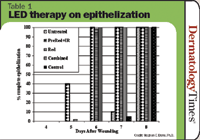- General Dermatology
- Eczema
- Chronic Hand Eczema
- Alopecia
- Aesthetics
- Vitiligo
- COVID-19
- Actinic Keratosis
- Precision Medicine and Biologics
- Rare Disease
- Wound Care
- Rosacea
- Psoriasis
- Psoriatic Arthritis
- Atopic Dermatitis
- Melasma
- NP and PA
- Skin Cancer
- Hidradenitis Suppurativa
- Drug Watch
- Pigmentary Disorders
- Acne
- Pediatric Dermatology
- Practice Management
- Prurigo Nodularis
Article
LED in wound healing safe, but is it effective?
Author(s):
Dr. White says the devices are being studied in diabetic wound healing, and that thus far, the results suggest that the use of light devices speed up healing.
National report - The use of light-emitting diode (LED) devices is now being investigated in studies for diabetic wounds and to eradicate scars.
"Most of the studies that have been conducted on LED devices have not been done in a split-fashion way," explains Lucile White M.D., a dermatologist and clinical instructor in the department of dermatology at Northwestern University in Chicago.
"The design would be where one half of the target is exposed to the LED device and the other half is not, and the results are then compared. We know that these low-level energy light sources are safe. The question is, they are effective?"
Dr. White says the devices are being studied in diabetic wound healing, and that thus far, the results suggest that the use of light devices speed up healing.

Consequently, many of these devices are advertised on the Internet, and consumers can purchase them and use them in their homes for various indications such as acne, Dr. White explains.
"It's the difference between a laser beam and a light bulb," Dr. White tells Dermatology Times. "The light from an LED or similar light sources is more diffuse and comes from a broader spectrum."
LEDs emit light of variable wavelengths and not monochromatic light.
Advantages
Some of the advantages of using low-intensity light therapy are that they are less expensive than laser therapy, are noninvasive and do not require anesthesia, sedation or harming of the skin, and promote ambulatory or at-home care.
Moreover, they produce little toxicity, according to Dr. White. Another advantage is that they can treat large areas of skin with one exposure.
"There is a very low risk of burning," Dr. White says, cautioning that they should not be placed directly on the skin. "They are also very easy to use."
Other future indications include smoothing out wrinkles and treating sore muscles, Dr. White predicts. The FDA has approved some LED devices for the treatment of muscle and joint pain.
Stephen C. Davis, Ph.D., a research associate professor in the department of dermatology and cutaneous surgery at the Miller School of Medicine at the University of Miami in Miami, explains the light has various mechanisms that aid in wound healing, such as the upregulation or downregulation of certain growth factors. The light can also have an impact on cell migration and proliferation, affecting the release of prostaglandins and cytokines, thereby enhancing the repair and healing process.
While there are some data from animal studies suggesting in vivo benefits of using LEDs in wound healing, there are limited comparable data from human studies, Dr. Davis notes. Moreover, Dr. Davis echoes Dr. White's opinion that the animal studies have not been adequately designed.
"We still need a lot of good clinical and pre-clinical, double-blinded, well-controlled trials to evaluate their impact," he says.
He has mainly studied light therapies in a porcine model, since it most closely duplicates human skin.
"More studies are needed to help elucidate optimal LED parameters such as wavelength, frequencies and treatment duration for various types of wounds."
Studies to date have also not compared delivery systems, such as pulsed light vs. continuous wave, to determine which is superior.
"Our skin is similar to porcine skin in that we heal wounds by re-epithelialization and some contraction," Dr. Davis explains. "Animals like rats, rabbits and dogs heal primarily through contraction."
Current LED devices being used for wound healing use wavelengths in the red and near infrared range.
Dr. Davis has been involved in several swine studies with LED devices, which have shown promising wound healing effects. In a study with some Canadian collaborators, Dr. Davis found LED was able to stimulate epithelialization of partial thickness wounds.
Similar beneficial effects were seen in another preliminary study with GentleWaves, a low-intensity light therapy that claims to activate the skin's natural rejuvenation process. The technology is currently FDA approved for the treatment of wrinkles around the eye.
Using photomodulation, the technology emits coded pulses of light. The emissions have been reported to have two effects: mitochondrial cells are stimulated to produce more collagen and the production of enzymes that break down and age skin tissue is slowed.
"We believe LED therapy is an exciting technology with promising indications for both wound healing and skin rejuvenation," Dr. Davis says.
"Additional studies are needed to determine optimal parameters for wound healing and/or skin rejuvenation."





